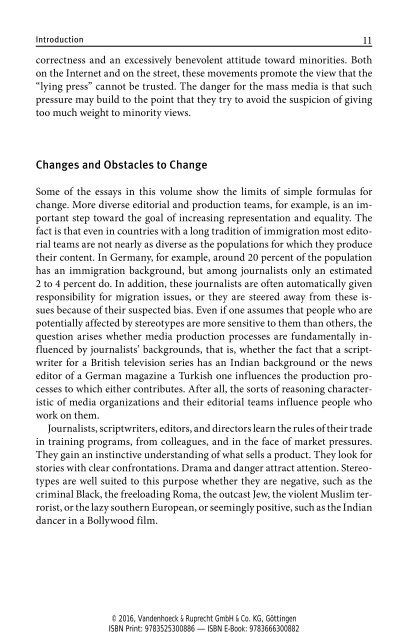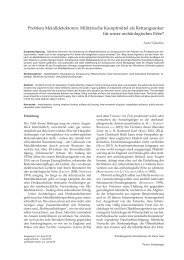Media and Minorities
9783666300882_ruhrmann_media_ebook_034247
9783666300882_ruhrmann_media_ebook_034247
You also want an ePaper? Increase the reach of your titles
YUMPU automatically turns print PDFs into web optimized ePapers that Google loves.
Introduction 11<br />
correctness <strong>and</strong> an excessively benevolent attitude toward minorities. Both<br />
on the Internet <strong>and</strong> on the street, these movements promote the view that the<br />
“lying press” cannot be trusted. The danger for the mass media is that such<br />
pressure may build to the point that they try to avoid the suspicion of giving<br />
too much weight to minority views.<br />
Changes <strong>and</strong> Obstacles to Change<br />
Some of the essays in this volume show the limits of simple formulas for<br />
change. More diverse editorial <strong>and</strong> production teams, for example, is an important<br />
step toward the goal of increasing representation <strong>and</strong> equality. The<br />
fact is that even in countries with a long tradition of immigration most editorial<br />
teams are not nearly as diverse as the populations for which they produce<br />
their content. In Germany, for example, around 20 percent of the population<br />
has an immigration background, but among journalists only an estimated<br />
2 to 4 percent do. In addition, these journalists are often automatically given<br />
responsibility for migration issues, or they are steered away from these issues<br />
because of their suspected bias. Even if one assumes that people who are<br />
potentially affected by stereotypes are more sensitive to them than others, the<br />
question arises whether media production processes are fundamentally influenced<br />
by journalists’ backgrounds, that is, whether the fact that a scriptwriter<br />
for a British television series has an Indian background or the news<br />
editor of a German magazine a Turkish one influences the production processes<br />
to which either contributes. After all, the sorts of reasoning characteristic<br />
of media organizations <strong>and</strong> their editorial teams influence people who<br />
work on them.<br />
Journalists, scriptwriters, editors, <strong>and</strong> directors learn the rules of their trade<br />
in training programs, from colleagues, <strong>and</strong> in the face of market pressures.<br />
They gain an instinctive underst<strong>and</strong>ing of what sells a product. They look for<br />
stories with clear confrontations. Drama <strong>and</strong> danger attract attention. Stereotypes<br />
are well suited to this purpose whether they are negative, such as the<br />
criminal Black, the freeloading Roma, the outcast Jew, the violent Muslim terrorist,<br />
or the lazy southern European, or seemingly positive, such as the Indian<br />
dancer in a Bollywood film.<br />
© 2016, V<strong>and</strong>enhoeck & Ruprecht GmbH & Co. KG, Göttingen<br />
ISBN Print: 9783525300886 — ISBN E-Book: 9783666300882







